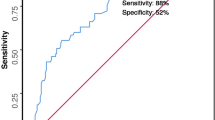Abstract
Physiological and operative severity score for enumeration of mortality and morbidity (POSSUM), as reported by Copeland et al. (Br J Surg 78: 355–60, 1991) [1] and its Portsmouth modification (P-POSSUM) [2], as reported by Whiteley et al. (Br J Surg 83:812–15, 1996), remain one of the most widely accepted risk assessment scoring system in surgical patients and helps in apprising both the surgeon and the relatives with the involved risk. They have been extensively studied since their development for various surgical procedures, and though most aspects of the scoring are standardized, the timing of physiological scoring is variable (admission vs. pre-operatively) in most of the studies. Hence, we aim to evaluate the predictive value of the score in the defined patients in our setup and also to evaluate which timing of scoring is more accurate, whether at the time of admission or pre-operatively after initial resuscitation. One hundred patients, who underwent surgery for acute abdomen from November 2016 to March 2018 at our institute, were studied. Mortality and morbidity risk were calculated for each P-POSSUM score with physiological scoring done twice, i.e., at admission and pre-operatively. The ratio of observed to predicted death and morbidity (O:E) were calculated and compared for both scores using chi-square test. Area under the curve (AUC) analysis was used to compare the efficacy of both the scores. An observed to expected (O:E) ratio of 0.88 and 1.00 was obtained for mortality with physiological scoring at admission and pre-operatively. Similarly, the O:E values for morbidity were 0.85 and 0.87 respectively. P-POSSUM was found to give an accurate prediction of both mortality and morbidity in patients operated for acute abdomen. Moreover, physiological scoring done with pre-operative variables is superior in comparison to scoring at the time of admission and is a better predictor of outcome.

Similar content being viewed by others
References
Cope V (1968) The early diagnosis of the acute abdomen, by Sir Zachary Cope. 13th ed. Oxford University Press, London
de Burlet K, Lam A, Larsen P, Dennett E (2017) Acute abdominal pain-changes in the way we assess it over a decade. N Z Med J 130(1463):39–44
Cervellin G, Mora R, Ticinesi A et al (2016) Epidemiology and outcomes of acute abdominal pain in a large urban emergency department: retrospective analysis of 5,340 cases. Ann Transl Med 4(19):362. https://doi.org/10.21037/atm.2016.09.10
Copeland GP, Jones D, Walters M (1991) POSSUM: a scoring system for surgical audit. Br J Surg 78:355–360
Copeland GP (1993) Comparative audit: fact versus fantasy (for debate). Br J Surg 80:1424–1425
Bennett-Guerrero E, Hyam JA, Shaefi S, Prytherch DR, Sutton GL, Weaver PC, Mythen MG, Grocott MP, Parides MK (2003) Comparison of PPOSSUM risk-adjusted mortality rates after surgery between patients in the USA and the UK. Br J Surg 90:1593–1598
Kumar S (2013) Comparison of POSSUM and P-POSSUM as audit tools in patients undergoing emergency laparotomy for secondary bacterial peritonitis. Glob J Med Res 13(3):7–11
Jain AK, Sharma D (2016) A prospective study of risk stratification in patients undergoing emergency laparotomy with POSSUM and P-POSSUM. Int Surg J 3:207–210
Kumar P, Rodrigues GS (2009) Comparison of POSSUM and P-POSSUM for risk-adjusted audit of patients undergoing emergency laparotomy. Dig Surg 26(1):75–79
Mohil RS, Bhatnagar D, Bahadur L, Rajaneesh DDK, Magan M (2004) POSSUM and P-POSSUM for riskadjusted audit of patients undergoing emergency laparotomy. Br J Surg 91:500–503
Tekkis PP, Kocher HM, Bentley AJ, Cullen PT, South LM, Trotter GA et al (2000) Operative mortality rates among surgeons: comparison of POSSUM and P-POSSUM scoring systems in gastrointestinal surgery. Dis Colon Rectum 43:1528–1532
Tekkis PP, Kessaris N, Kocher HM, Poloniecki JD, Lyttle J, Windsor AC (2003) Evaluation of POSSUM and P-POSSUM in patients undergoing colorectal surgery. Br J Surg 90:340–345
Raut NR, Maibam C, Singh J, Devi SR, Singh TA (2013) Portsmouth physiological and operative severity score for the enumeration of mortality and morbidity scoring system in general surgical practice and identifying risk factors for low outcome. J Med Soc 27:119–123
Poon JT, Chan B, Law WL (2005) Evaluation of P-POSSUM in surgery for obstructing colorectal cancer and correlation of the predicted mortality with different surgical options. Dis Colon Rectum 48:493–498
Chatterjee AS, Renganathan DN (2015) POSSUM: a scoring system for perforative peritonitis. J Clin Diagn Res 9(4):PC05–PPC9. https://doi.org/10.7860/JCDR/2015/12720.5854
Hong S, Wang S, Xu G, Liu J (2017) Evaluation of the POSSUM, p-POSSUM, o-POSSUM, and APACHE II scoring systems in predicting postoperative mortality and morbidity in gastric cancer patients. Asian J Surg 40(2):89–94
Wilson J, Woods I, Fawcett J, Whall R, Dibb W, Morris C, McManus E (1999) Reducing the risk of major elective surgery: randomised controlled trial of preoperative optimisation of oxygen delivery. BMJ 318:1099–1103
Mcllroy B, Miller A, Copeland GP, Kiff R (1994) Audit of emergency preoperative resuscitation. Br J Surg 81:200–202
Whiteley MS, Prytherch DR, Higgins B, Weaver PC, Prout WG (1996) An evaluation of the POSSUM surgical scoring system. Br J Surg 83:812–815
Prytherch D, Whiteley MS, Higgins B, Weaver PC, Prout WG, Powell SJ (1998) POSSUM and Portsmouth POSSUM for predicting mortality. Br J Surg 85:1217–1220
Author information
Authors and Affiliations
Corresponding author
Ethics declarations
Conflict of Interest
Authors declare that they have no conflict of interest.
Informed Consent
Informed consent was obtained from all individual participants included in the study.
Ethical Approval
All procedures performed in studies involving human participants were in accordance with the ethical standards of the Institutional Ethics committee and with the 1964 Helsinki declaration and its later amendments or comparable ethical standards.
Additional information
Publisher’s Note
Springer Nature remains neutral with regard to jurisdictional claims in published maps and institutional affiliations.
Rights and permissions
About this article
Cite this article
Garg, N., Bandi, A. Evaluation of Predictive Value of P-POSSUM Score in Patients Operated for Acute Abdomen and Comparison of Scoring at Admission and Pre-operatively. Indian J Surg 83, 188–193 (2021). https://doi.org/10.1007/s12262-020-02233-8
Received:
Accepted:
Published:
Issue Date:
DOI: https://doi.org/10.1007/s12262-020-02233-8




